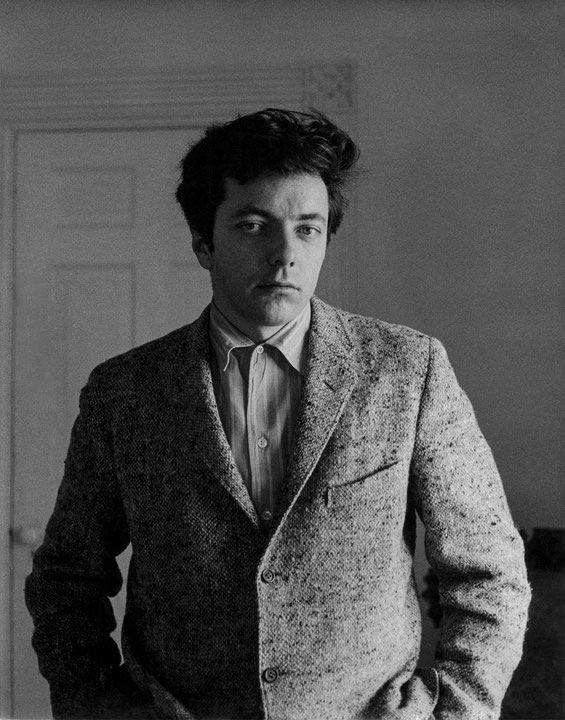
William Ronald, born William Ronald Smith in 1926 in Stratford, Ontario, stands as a monumental figure in Canadian art history, particularly for his role in advancing abstract expressionism in the country. His early life, shaped by the quaint environments of small towns like Fergus and Brampton, Ontario, provided a humble backdrop to the ambitions that would later see him rise to international acclaim.
From a young age, Ronald was drawn to the arts, with a particular passion for painting. His early artistic inclinations were nurtured by a high school teacher, Myrtle Strait, who recognized his potential and encouraged him to pursue a career in art. However, Ronald's interests were not confined solely to painting. He was also an avid boxer, a pursuit that perhaps contributed to the bold and dynamic energy that would later characterize his abstract works.
After high school, Ronald enrolled at the Ontario College of Art in 1947, where he studied under influential Canadian artists such as Will Ogilvie, Carl Schaefer, and J.W.G. MacDonald. However, Ronald's tenure at the college was not without challenges. Disheartened by the criticism of some instructors, he briefly left the college. It was J.W.G. MacDonald, a pioneer in Canadian abstract art, who recognized Ronald's talent and persuaded him to return and complete his studies. Ronald did so, graduating with First Class Honours in 1951, and soon after began making a name for himself in the Canadian art scene.
The early 1950s were a period of exploration and experimentation for Ronald. He dabbled in various mediums, including casein, duco, oils, and watercolours, which attracted significant attention. Ronald's work during this period reflected his growing interest in abstraction, a style that was not yet widely embraced in Canada. His involvement with groups such as the Canadian Society of Painters in Water Colour, the Ontario Society of Artists, and the Royal Canadian Academy of Arts further solidified his place in the artistic community.

In 1953, Ronald played a pivotal role in the formation of Painters Eleven, a group of abstract artists who sought to challenge the conservative tendencies of the Canadian art establishment. The group, which included notable artists like Jack Bush, Ray Mead, and Tom Hodgson, held its first exhibition in 1954 at Roberts Gallery in Toronto. The show was a watershed moment for Canadian abstract art, drawing the largest crowd in the gallery's history and marking the beginning of a new era in Canadian painting.
In 1955, Ronald made a bold move to New York, where he quickly gained recognition in the city's vibrant art scene. His association with the prestigious Kootz Gallery, run by Samuel Kootz, was instrumental in his success. Ronald's first solo show at Kootz Gallery in 1957 was a critical and commercial triumph, establishing him as a significant figure in the international art world.
Despite his success in New York, Ronald's career was not without its challenges. The shift in popular taste towards Pop Art in the early 1960s left Ronald struggling to maintain his audience. His refusal to conform to the new trends led to a parting of ways with Kootz in 1963, marking the end of a significant chapter in his career.
Returning to Canada in 1965, Ronald faced a period of personal and professional turmoil. Struggling with depression and the effects of drug withdrawal, he found solace in the support of his family and the community at St. Andrew-by-the-Lake, where he created a stunning abstract mural in the chapel. This mural, characterized by its vibrant colors and symbolic content, was a testament to Ronald's enduring creative spirit.
In the years that followed, Ronald continued to paint and experiment with different forms and mediums. His works from the late 1960s and 1970s, including the monumental mural "Tribute to Robert F. Kennedy" at the National Arts Centre in Ottawa, are among his most celebrated achievements. This mural, with its flowing lines and expressive use of color, is a fitting tribute to a man whose life and work were marked by a relentless pursuit of artistic excellence.
Ronald's legacy as an artist is also evident in his contributions to Canadian television. His role as the host of CBC's "The Umbrella" in the 1960s brought the arts into Canadian homes and demonstrated his ability to engage with the public in new and innovative ways.
In the 1980s, Ronald embarked on his "prime ministers" project, a series of portraits of Canada's prime ministers. These works, characterized by their abstract and allegorical approach, were a departure from traditional portraiture and reflected Ronald's unique perspective on history and politics.
Throughout his career, William Ronald remained a maverick, a visionary artist who refused to be constrained by convention. His contributions to Canadian art, both as a member of Painters Eleven and as an individual artist, have left an indelible mark on the cultural landscape of the country. Ronald's work continues to be celebrated for its boldness, its innovation, and its unyielding commitment to the principles of abstract expressionism.
Browse our collection of Canadian paintings for sale at the Canadian Classic Fine Art gallery, The best place to buy a painting online. We provide free shipping anywhere in Canada and the United States. Our Montreal art gallery sells paintings online exclusively and have a 14 days return policy.
